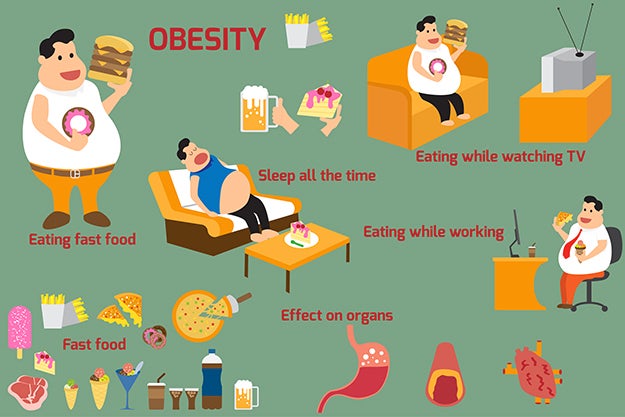Risk factors for dyslipidemia
All people should control their cholesterol and triglyceride levels. Due to various risk factors, some of us may be more predisposed to potential heart problems than others. There are certain risks you cannot control, such as your age or genes. However, you can control a number of risk factors to lower your cholesterol and triglyceride levels and decrease your chances of developing cardiovascular disease (CVD). 1 You need to know your risk factors based on your health profile and adopt a lifestyle that can preserve your health.
Discuss your risk factors of dyslipidemia with your doctor and the ways to reduce those risks.
Maintain a healthy lifestyle to lower your dyslipidemia risk
Your lifestyle has much to do with your cholesterol and triglyceride levels, this is why you need to keep it under control. Look at the risk factors you can influence below:
A. Obesity

Obesity increases bad cholesterol and triglyceride levels and decreases good cholesterol. 2 Obese people have excess visceral fat. Visceral fat envelops our internal organs, such as the liver and heart. 3
People who carry excess weight around their midsection are at a higher risk of high cholesterol and triglycerides because the fat is located around their organs, as opposed to people who have excess weight around their hips, thighs, and bottom. 3 Being overweight means your heart must work harder to move blood around your body, leading to high blood pressure.
Tips to lower obesity:
- Maintain a healthy diet by limiting saturated fat found in cheese, pork, and butter 4
- Switch to healthier options, such as fruits, vegetables, and fish
- Increase your physical activity
- Calculate your body mass index (BMI) to determine if you are healthy, overweight, or obese 3
| Did you know? Because BMI does not take muscle mass into consideration, you might belong to the obese category if you are very muscular. 3 Therefore, it is important to determine your optimal BMI with your doctor. (link to BMI calculator on a:care) |
B. Tobacco

Smoking is another factor that lowers your level of good cholesterol. 5 Approximately 5,000 chemical components are found in cigarette smoke, and hundreds of them are bad for your health.6
| Thousands of people quit smoking every year. It is your turn! Stop hurting yourself and those around you. |
C. Unhealthy

Even if you are not overweight, a healthy diet is one of the most powerful weapons to lower your cholesterol and triglyceride levels.
Tips to maintain a healthy diet:
- Limit intake of saturated fats and whole milk dairy products (link article 5)
- Reduce your alcohol consumption. When alcohol enters your body, it is broken down and rebuilt into triglycerides and cholesterol. If your triglyceride levels are too high, the liver does not function properly to eliminate bad cholesterol. Thus, drinking alcohol raises cholesterol and triglyceride levels. 7 In addition, alcohol consumption can lead to increased blood pressure and weight gain, 11 which are both risk factors for developing dyslipidemia.
D. Lack of physical exercise

An inactive, sedentary lifestyle lowers your level of good cholesterol, 5 which means that it is harder for your body to remove bad cholesterol and triglycerides from your arteries. One hundred and fifty minutes of moderate-intensity exercise per week will lower your cholesterol and triglyceride levels. 5 (link article 6)
E. High stress

Stress has been confirmed as a cause of weight gain and unhealthy diets, which are factors known for increasing cholesterol and triglyceride levels. 8 If you experience stress at work, you have a greater likelihood of developing high cholesterol and triglyceride levels. Physical activities will help to lower your stress level. 8
| The more risk factors you have, such as those mentioned above, the greater your risk of developing high cholesterol and triglycerides. If you have high cholesterol and you have unhealthy habits, such as those listed above, you have a higher risk of developing cardiovascular diseases or even having a heart attack or stroke. Do not hesitate to discuss with your doctor how to change your lifestyle. He or she will be a key asset to ensuring your heart health! |
There are risk factors you cannot control
A. Age

The risk of developing high cholesterol and triglyceride levels increases with age, particularly after age 50. If you have high cholesterol and triglyceride levels at a young age, it increases your risk of having a heart attack or stroke.
ฺ
B. Heredity

Familial hypercholesterolemia (FH) is an inherited disease that causes high levels of low-density lipoproteins (LDL), commonly referred to as ‘bad’ cholesterol.10 In this circumstance, the likelihood of a genetic disorder is increased, and the family history assumes an even greater importance. If your family has high cholesterol, it is important to know their cholesterol history. In addition, if you have FH, there are medical options available to lower your cholesterol. It is crucial that you discuss these options with your doctors.
| Whatever the risks and causes of dyslipidemia, your doctor will be the best person to talk to about this issue. Do not hesitate to consult them for additional information. |












